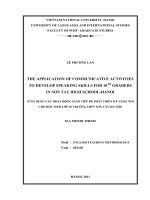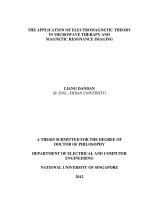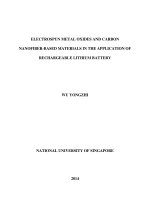- Trang chủ >>
- Sư phạm >>
- Sư phạm vật lý
Application of 1H DOSY NMR in Measurement of Polystyrene Molecular Weights
Bạn đang xem bản rút gọn của tài liệu. Xem và tải ngay bản đầy đủ của tài liệu tại đây (789.01 KB, 6 trang )
<span class='text_page_counter'>(1)</span><div class='page_container' data-page=1>
16
Original Article
Application of
1H DOSY NMR in Measurement of
Polystyrene Molecular Weights
Nguyen Hoai Nam, Nguyen Huu Tho, Nguyen Minh Ngoc, Pham Quang Trung
<i>Faculty of Chemistry, VNU University of Science, Vietnam National University, Hanoi, </i>
<i>19 Le Thanh Tong, Hoan Kiem, Hanoi, Vietnam </i>
Received 17 June 2019
<i>Revised 22 September 2019; Accepted 26 February 2020 </i>
<b>Abstract: In this work, we studied the applicability of diffusion ordered nuclear magnetic resonance </b>
spectroscopy (DOSY NMR) as an alternative method in determination of polystyrene molecular
weight. DOSY NMR spectroscopy allows measuring the diffusion coefficient of molecule which
<i>directly depend on hydrodynamic radius and so on, average molar mass in weight (M</i>w). By using
commercial polystyrene (PS) standards, an external calibration curve was established. Based on the
<i>excellent linear correlation between diffusion coefficient (logD) and molecular weight (logM), the </i>
molecular weight of polystyrene can be predicted using the following equation 𝑙𝑜𝑔𝐷 =
<i>−0.6512𝑙𝑜𝑔𝑀 − 7.2686. The validation was done by comparing with the M</i>w value obtained by gel
permeation chromatography within less than 5% deviation. From the diffusion coefficient, some
property of polystyrene in solution, such as Flory coefficient and polymer-solvent interaction, were
also studied. The Flory coefficient confirmed that chloroform is a good solvent for PS.
<i>Keywords: Diffusion coefficient, molecular weights, diffusion ordered NMR spectroscopy. </i>
<b>1. Introduction </b>
One of key parameters that affects the
physical properties of polymers, thus its
application, are the molecular weights (MW) and
weight distributions. Because all synthesized
polymers have a certain polydispersity, we only
concern the term average molecular weight.
These average MWs can be revealed through
________
<sub>Corresponding author. </sub>
<i> Email address: </i>
</div>
<span class='text_page_counter'>(2)</span><div class='page_container' data-page=2>
required. Additionally, the problem of solubility
could rise when changing solvent and it could
damage expensive GPC columns. Finally, it is
not possible to get a reliable result of molecular
weight with low MW (<2000 g/mol).
Diffusion ordered nuclear magnetic
resonance spectroscopy (DOSY NMR) is
usually used to measure the diffusion parameter
of molecule by applying a gradient pulse (pulse
field gradient - PFG). The basic theory of this
method has been well described in the
literature[1,2]. As the diffusion parameter is
sensitive to molecular weight (molecular size
and shape), the relationship between molecular
weight (here weight average molecular weight,
<i>Mw) and diffusion coefficient (D) has been </i>
determined as follows:
log 𝐷 = log 𝐴 + 𝛼 log 𝑀 (1)
<i>Where A and are the constants that depend </i>
on the nature of polymer used. To obtain the
<i>linear relationship between logD and logM, </i>
different parameters such as convection,
temperature, and viscosity must be well
controlled. The highly diluted concentration will
ensure the viscosity, density and random
movement without interaction condition, so that
the linear relationship can be achieved.
Through enhancement and extensions of
PFG technique, DOSY NMR provides a
versatile tool for the determination of not only
molecular weight but also the polydispersity of
<i>polymers. Neufeld et al. used DOSYNMR </i>
technique for molecular weight determination of
<i>small molecules [3]. Delsuc et al. presented a </i>
DOSY method based on maximum entropy
method for reveal of weight distribution of
polysaccharides and polymer systems[4,5].
Other researchers studied the application of
DOSY NMR for controlled-radical
polymerization systems [6-8] and block
copolymers[9].
In this work, we study the applicability of
DOSY NMR as an alternative method in
determination of polystyrene molecular weight.
The processing method parameters, as well as
the calibration with appropriate standards are
also discussed. The method validation is
conducted by comparing the DOSY-based
molecular weight values with weight average
<i>molecular weight (Mw</i>) obtained from GPC
measurements.
<b>2. Experimental </b>
<i>2.1. Chemicals </i>
Polystyrene standards were obtained from
Sigma-Aldrich. Styrene was obtained from
Sigma-Aldrich and redistilled under reduced
pressure to eliminate inhibitors. 2,2–
azobisisobutyronitrile (AIBN) was purchased
from Sigma-Aldrich and purified by
recrystallization from methanol. Toluene was
purchased from Fisher, refluxed in
sodium/benzophenone to remove water and
oxygen before redistilled and stocked over
molecular sieves (2.4 Å) prior to use. N-hexane
was purchased from Fisher and used without
further purification.
<i>2.2. Polystyrene synthesis </i>
PS samples were synthesized by
Free-Radical Polymerization (FRP) using AIBN as
initiator, under nitrogen atmosphere. A solution
containing 3.134 g of styrene (3.0×10-2<sub> mol) and </sub>
17.0 mg of AIBN (1.0×10-4<sub> mol) in toluene was </sub>
introduced in a 100 mL three-neck flask. The
reaction solution was then degassed by nitrogen
bubbling for 45 minutes. After degassing
process, the reaction mixture was heated to 70°C
in a constant-temperature oil bath for 24 h. The
polymerization was stopped by rapidly cooling
in ice water and by opening the polymerization
flask to air. This mixture was then precipitated in
n-hexane, filtered, and dried under vacuum for
24 h giving a white solid (PS).
<i><b>2.3. Characterization </b></i>
<i>2.3.1. NMR Experiment </i>
</div>
<span class='text_page_counter'>(3)</span><div class='page_container' data-page=3>
(Faculty of Chemistry, VNU University of
Science, Hanoi), using a 5 mm ATMA BBO
probe head. Each sample contained 3 mg of
polystyrene dissolved in 0.5 mL of deuterated
chloroform (CDCl3). Before measurement, all
samples were equilibrated at 298 K for at least 5
minutes to avoid a temperature gradient along
the sample tube. The spinning could also lead to
a convection [1], so it must be deactivated.1<sub>H </sub>
and 1D DOSY experiments were performed
<i>usingzg30and ledbpgp2s1dpulse program with </i>
16 scans. 2D DOSY experiments were
<i>performed using the standard ledbpgp2s pulse </i>
program employing a stimulated bipolar echo
sequence with longitudinal eddy current delay
(LED). Smoothed rectangle gradient pulse
shapes were used throughout. The gradient pulse
duration was varied from 0.5 to4 ms. Diffusion
time were set at 100 – 2000 ms.8 step increments
were defined for all acquisitions.
FID data were processed by Topspin 3.5
software, Bruker Biospin. Fourier transform was
<i>performed by the command xf2, line broadening </i>
0.3 Hz was applied to all spectra. 2D DOSY
spectrum was generated using
Lavenberg-Marquardt algorithm. From 2D DOSY spectrum,
diffusion coefficients of a chosen narrow
chemical shift range can be calculated thank to
Topspin 3.5 software [4,5].
<i>2.3.2. GPC Characterization </i>
The average molecular weights of
synthesized polystyrene samples were
investigated by GPC using a Water 501 pump
equipped with a 2690D separation module and
two detectors (Refractive-index detector DRI
410 and UV detector Kontron 432).
Tetrahydrofuran (THF) was used as eluent at
30°C and at a flow rate of 1.0 mL/min. The
polymer molecular weight was compared against
<i>narrow standards of PS (Mp</i> from 620 to 3.6×105
g/mol).
<b>3. Results and Discussion </b>
<i>3.1. Optimization of 1<sub>H DOSY NMR measurement </sub></i>
The 1<sub>H NMR spectrums of PS synthesized </sub>
(above) and a standard PS (below) in Figure 1
shows four main signals in two regions. In the
first region, from 1.0-2.0 ppm, there are two
peaks corresponding to the protons of aliphatic
chains of polymer. The second region, from
6.2-7.1 ppm, contains signals corresponding to the
aromatic protons. Before running 2D DOSY
experiment, the gradient pulse length and the
diffusion time were optimized to detect whole
decay function properly. The optimization was
done by 1D DOSY measurements. The first 1D
DOSY started with value of 50 ms for and 1.4
ms for and with 2% amplitude of gradient pulse
(1.0 G/cm). Then the gradient strength was
increased up to 95% amplitude (45.78 G/cm),
and the values of and were changed until the
signal dropped to at least 5% of the residual
signal. The Figure 2 showed spectra of two 1D
<i>DOSY of the standard PS (Mw</i> = 4130 g/mol) at
2% (above) and 95% (below) amplitude of
gradient pulse, where the signal obtained at 95%
amplitude was already multiplied by 93 times. It
must be noted that increasing results bigger
reduction in signal, but this value is limited at 2.5
ms with SMSQ10.100 shape. After optimizing,
2D DOSY can be run with 8 increments, 32
scans each, and a linear gradient ramp. The total
duration of a 2D DOSY is 12 minutes. After
Fourier transform, the AU program DOSY in
<i>Topspin 3.5 give a pseudo-2D chemicalshift – </i>
<i>logD spectrum. The diffusion parameter can be </i>
</div>
<span class='text_page_counter'>(4)</span><div class='page_container' data-page=4>
Figure 1. 1<sub>H NMR spectrum of PS synthesized by </sub>
<i>FRP and a standard PS (Mw</i> = 4130 g/mol).
Figure 2. Signal attenuation at gradient strength 2 %
(above) and 95% (below) amplitude (PS standard,
<i>Mw</i> = 4130 g/mol).
Figure 3. 2D DOSY NMR spectrum of PS
<i>synthesized by FRP and a PS standard (Mw</i> = 4130
g/mol).
<i>Another way to get the value of D is using </i>
Topspin T1/T2 package. If the values of and
were correctly optimized, an exponential free
decay was observed. Otherwise, the free decay
could be too fast or too slow [6]. The calculated
diffusion coefficients of all four peaks of a
<i>standard PS (Mw</i>=4130 g/mol) are shown in
Table 1 as example. It is shown that the diffusion
coefficients of all peaks of the same molecule
<i>had a similar value of D. The diffusion </i>
coefficient of peak at 6.50 ppm was chosen for
further calculation, because this signal was not
overlapped, therefore there was no convection.
Table 1. Diffusion coefficients of four peaks of PS
<i>(Mw</i> = 4130 g/mol) calculated by Topspin 3.5 T1/T2
package
Peak (ppm) 7.03 6.50 1.77 1.36
</div>
<span class='text_page_counter'>(5)</span><div class='page_container' data-page=5>
<i>3.2. Calibration </i>
Commercial narrow standards of PS (GPC
standards) were selected to construct the
calibration curve. Table 2 and Figure 4 show
detailed results of calibration curve in
<i>chloroform. The R2</i><sub> value equal to 0.993 </sub>
<i>provided an excellent linearity of the log D-log </i>
<i>M curve, over a very wide range of molecular </i>
<i>weight. From calibration curve, the value of df</i> is
determined as 0.65. This value is close to the
theoretical value, so the Flory coefficient of PS
in chloroform is 1/𝑑<sub>𝑓</sub> = 1.54. It can be confirmed
that chloroform is a good solvent for PS [10].
<i>Table 2. D-Mw</i> results of PS standard calibration curves
Sample <i>Mw</i>(GPC)
(g/mol) <i>D (10</i>
-11<sub> m</sub>2<sub>/s)</sub> <i><sub>Log D Log M</sub></i>
<i>w</i>
PS 4130 23.6 -9.63 3.62
PS 19300 10.6 -9.97 4.28
PS 114000 2.75 -10.56 5.04
PS 223000 1.63 -10.79 5.35
PS 567700 0.91 -11.04 5.75
PS 2000000 0.35 -11.46 6.30
PS 6300000 0.25 -11.60 6.80
<i>Figure 4. Calibration curve of log D – log M. </i>
<i>Table 3. D – Mw</i> of PS standard validation and PS
(FRP) prediction
Sample Mw (GPC)
(g/mol)
D
(10-11<sub>) </sub>
(m2<sub>/s) </sub>
Mw (DOSY)
(g/mol) Dev.
PS 9000 14.79 8577 4.50 %
PS 50000 1.03 51000 2.00 %
PS (FRP) 23228 7.64 23779 2.30 %
<i>3.3. Validation and Application </i>
We applied the calibration curve with two
another narrowly dispersed standard samples for
validation. First, the molecular weight of two
standard samples were measured by GPC, and
we obtained the results matched the specification
of standards, confirming the accuracy of GPC
(Table 3). Second, the 2D DOSY of two
commercial samples and a PS synthesized by
FRP were measured. From the calibration curve,
<i>the Mw </i>values obtained show a good correlation
with small deviation (< 5 %). It is noted that all
samples, including the calibration curve, were
not measured at the same time, same day, but in
several weeks. With the very stable of magnetic
and gradient field, it is no need to recalibrate but
we can use the calibration curve for a long time.
<b>4. Conclusion </b>
1<sub>H DOSY NMR is a simple and convenient </sub>
method for the determination of the molecular
weight of PS and its hydrodynamic properties in
chloroform. This method is used to measure the
<i>average diffusion coefficient D of PS samples of </i>
<i>increasing Mw</i> ranging from thousands to
millions gram per mole, with the deviation
below 5%. The highly linear and stable
calibration curve could be used for monitoring
<i>the Mw</i> value of various types of PS. With a Flory
coefficient value equal to 1.54, it is confirmed
that CDCl3 is a good solvent for PS.
In complementary with GPC, Light
Scattering (LS) and MALDI-TOF-MS, 1<sub>H </sub>
DOSY NMR appearsto be an interesting tool for
the determination of polymer molecular weights.
<b>Acknowledgement </b>
This research received funding support from
RoHan Catalysis project.
<b>References </b>
[1] C.S. Johnson Jr, Diffusion ordered nuclear
magnetic resonance spectroscopy: principles and
y = -0,6512x - 7,2686
R² = 0,993
-12
-11,5
-11
-10,5
-10
-9,5
-9
3 4 5 6 7
<b>lo</b>
<b>g</b>
<b> D</b>
</div>
<span class='text_page_counter'>(6)</span><div class='page_container' data-page=6>
applications, Prog. Nucl. Magn. Reson.
Spectrosc. 34 (1999) 203-256.
10.1016/S0079-6565(99)00003-5.
[2] N.M. Loening, J. Keeler, G.A. Morris,
One-dimensional DOSY, J. Magn. Reson. 153 (2001)
103-112.
[3] R. Neufeld, D. Stalke, Accurate molecular weight
determination of small molecules via
DOSY-NMR by using external calibration curves with
normalized diffusion coefficients, Chem. Sci. 6
(2015) 3354-3364.
00670H.
[4] M.A. Delsuc, T.E. Malliavin, Maximum entropy
processing of DOSY NMR spectra, Anal. Chem.
70 (1998) 2146-2148.
9800715.
[5] J. Viéville, M. Tanty, M.A. Delsuc, Polydispersity
index of polymers revealed by DOSY NMR, J.
Magn. Reson. 212 (2011) 169-173. https://doi.
org/10.1016/j.aca.2009.06.049.
[6] W. Li, H. Chung, C. Daeffler, J.A. Johnson, R.H.
Grubbs, Application of 1<sub>H DOSY for facile </sub>
measurement of polymer molecular weights,
Macromolecules 45 (2012) 9595-9603. https://
doi.org/10.1016/j.jmr.2011.06.020.
[7] W.A. Braunecker, N.V. Tsarevsky, A. Gennaro,
K. Matyjaszewski, Thermodynamic components
of the atom transfer radical polymerization
equilibrium: quantifying solvent effects,
Macromolecules 42 (2009) 6348-6360. https://
doi.org/10.1021/ma301666x.
[8] P.G. Clark, E.N. Guidry, W.Y. Chan, W.E.
Steinmetz, R.H. Grubbs, Synthesis of a molecular
charm bracelet via click cyclization and olefin
metathesis clipping, J. Am. Chem. Soc. 132
(2010) 3405-3412.
1094s.
[9] S. Viel, M. Mazarin, R. Giordanengo, T.N. Phan, L.
Charles, S. Caldarelli, D. Bertin, Improved
compositional analysis of block copolymers
using diffusion ordered NMR spectroscopy, Anal
Chim Acta. 654 (2009) 45-48.
1021/ja9090337.
[10] C. Chamignon, D. Duret, M.T. Charreyre, A.
Favier,1<sub>H DOSY NMR determination of the </sub>
</div>
<!--links-->
application of back-propagation neural network in data forec
- 23
- 386
- 0








